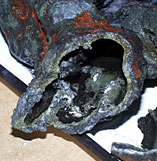|
|
  TODAY'S WEATHER Sunny 80°F (26.7°C) Latitude: 25 deg 20.17’S Longitude: 70 deg 02.31’E Wind Direction: NE Wind Speed: 10 Knots Sea State 2 Swell(s) Height: 2-4 Foot Sea Temperature: 78°F (25.6°C) Barometric Pressure: 1014.2 MB Visibility: 18+ Nautical Miles  A piece of a black chimney collected by ROV Jason. The chimney wall is only 0.5 cm thick (about one-fifth of an inch.  Elevator Recovery 
April 18, 2001 By Amy Nevala Mustard yellow, carrot orange and cinnamon brown are the colors of the rocks we collect at the hydrothermal vents. Turn one of these rocks in your hand and watch for the glittering gold crystals, a mineral called pyrite. Brought from the seafloor and displayed in Knorr’s main lab, they transform the stained wood table into a sparkling jewelry store display. “Their metallic luster makes them some of the most eye-catching rocks found on the seafloor,” said Geochemist Susan Humphris. The minerals that make up the rocks are called sulfides, and the sulfides’ official names are tongue twisters: sphalerite, chalcopyrite and wurtzite. They owe their sparkling existence to the hot, mineral-spurting hydrothermal vents. Here in the Indian Ocean, when we watch the super-heated hydrothermal fluids gush from cracks in the seafloor and mix with the icy seawater, we are seeing the formation of this new sulfide rock. Studying these sulfide rocks aids us in several ways. We learn more about the habitat of shrimp, bacteria and other vent organisms. This helps us to better understand the environment in which these organisms live. We also learn from sulfides more about the origin of ores containing copper. Many ancient copper deposits now on land formed at the bottom of the ocean. We use copper for many things, from coins to wires in computers and telephones. “When we look at a hydrothermal vent, we are watching a mineral deposit forming before our eyes,” said Susan. “This tells us a lot more about how they form than by studying mineral deposits on land that are millions of years old.” Susan collects the sulfide rocks using ROV Jason to break chunks from the black smoker chimneys and gather old sulfides from the seafloor. Once on board, Susan photographs, describes and catalogs each rock. Some she cuts with a ceramic saw to share with Microbiologist Anna-Louise Reysenbach. Anna-Louise grinds the rock and extracts from the grounds microbial genetic material called DNA to determine what bacteria live on the chimney. When the expedition ends, Susan will take over 250 pounds of sulfide rocks back to her lab for analysis. With her Woods Hole colleagues, she will examine what minerals are present and determine the chemical composition of the rocks. She will continue to work with other scientists as well. For example, she will combine the information she learns with that of Chemist Karen Von Damm, who studies the hydrothermal vent fluids that create sulfide rock. But today, Susan was still in the beginning stages of her rock processing as we turned away from 25°S for the last time. After a successful night collecting samples of water, rocks and organisms, we released our elevator from the seafloor and retrieved Jason. Early this afternoon, we bid farewell to the Kairei Vent Field. Though excited about the many rocks, shrimp, crabs and bacteria we collected here, we are looking forward to further exploring 24°S, where two days ago we located a large - and promising - hydrothermal plume, one sign of a still undiscovered hydrothermal vent field.
|
||||||||||||||||||||||||||||||||||||||||||||||||||||||||||||||||||||||||||||||||||||||||||||||||||||||||||||||||
Mailing List | Feedback | Glossary | For Teachers | About Us | Contact
© 2010 Dive and Discover™. Dive and Discover™ is a registered trademark of
Woods
Hole Oceanographic Institution